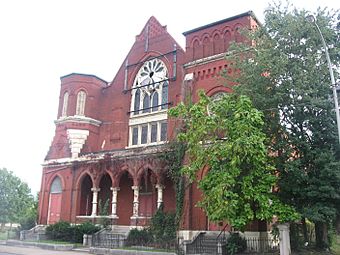Chestnut Street Baptist Church facts for kids
The Chestnut Street Baptist Church is a very old and important church located in Louisville, Kentucky. It was built a long time ago, in 1884. This church is special because it's listed on the National Register of Historic Places, which means it's a building that's important to the history of the United States.
About the Chestnut Street Baptist Church
This beautiful church, sometimes also called Quinn Chapel African Methodist Episcopal Church, stands at 912 West Chestnut Street. It was added to the National Register of Historic Places in 1980. This list includes places that are important to our country's history and culture.
A Special Design
The Chestnut Street Baptist Church was designed by a talented architect named Henry Wolters, who was born in Germany. He created an amazing building in the Gothic Revival style. This style often looks like old European cathedrals.
The church is made of red brick and has many fancy decorations made from terra cotta. Terra cotta is a type of baked clay. The front of the church has a central section with a pointed roof, called a gable. On each side of this central part, there are two tall towers.
Its Important History
The Chestnut Street Baptist Church is important for two main reasons. First, it's a great example of Gothic Revival church design in Louisville. Second, it played a big part in the history of one of the city's first and most important Black communities. It was a central place for people to gather and worship.




